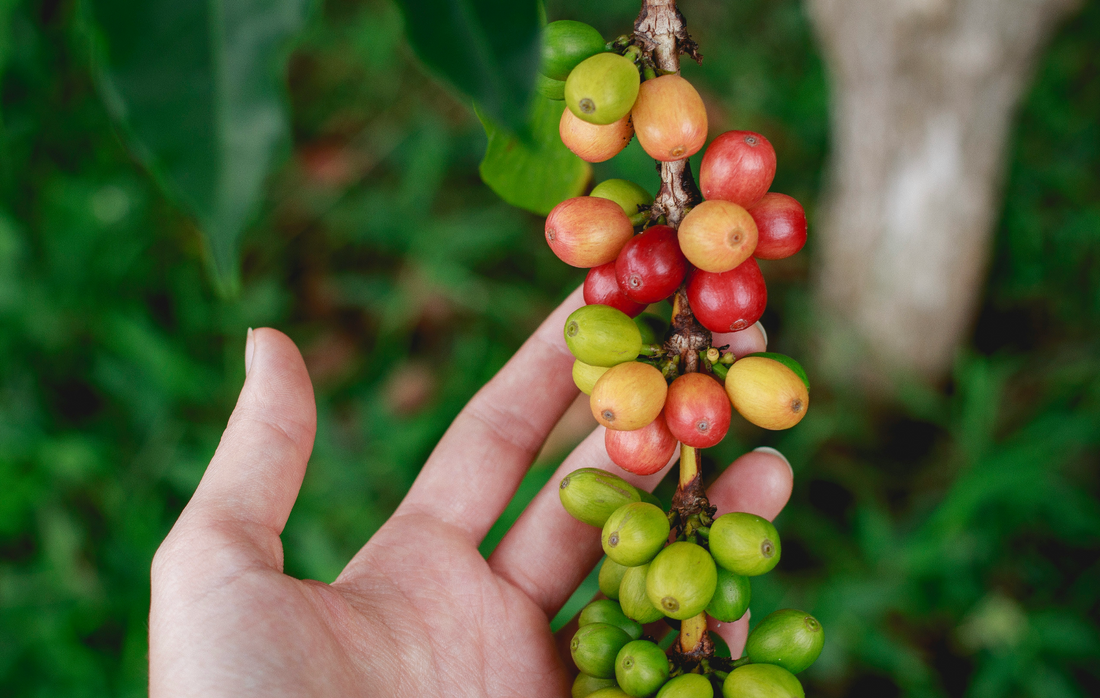From the farm to your mug, there are five major components to creating the coffee you enjoy: Process, Environment, Variety, Roasting, and Brewing. Join us as we uncover each of these elements so are able to appreciate the intricacies of a great cup of coffee.
Coffee Species vs. Varietals
There are more than 100 coffee species in the wild, but the main players are:
-
Arabica – delicate, complex, full of flavor nuance. This is the backbone of specialty coffee.
-
Robusta – bold, higher caffeine, more bitter, used in instant coffee or espresso blends for body. Easiest to grow, due to its resistance from disease and insect decay.
Within the Arabica species, things get interesting. Over centuries, farmers, researchers, and even nature itself have created many varietals (sometimes called cultivars or hybrids). Each varietal has its own personality: some produce more fruit, some resist disease better, some are prized for their jaw-dropping flavors. Additionally, many varietals have sub-varieties which contribute to their rarity
Six Common Specialty Coffee Varietals
Within the Arabica family, there are countless varietals. Just like you can tell the difference between a Gala apple and a Honeycrisp, each coffee varietal carries its own unique flavor and character.
1. Typica
One of the oldest and most “classic” coffee varietals. Typica is like the ancestor of many others.
-
Taste: Sweet, smooth, balanced. Think gentle chocolate or nuts with mild acidity.
-
Tradeoff: The plants are tall, produce less coffee, and are vulnerable to disease. That’s why you don’t see Typica as much today — but when you do, it’s worth noticing.
2. Bourbon
A natural mutation of Typica discovered centuries ago on an island called Bourbon
-
Taste: Round, rich, sweet. Often has fruit notes with brown-sugar depth.
-
Tradeoff: Still delicate and disease-prone, but usually more flavorful than Typica. Many Latin American coffees you drink today trace back to Bourbon.
3. Caturra
A shorter (dwarf) version of Bourbon discovered in Brazil.
-
Taste: Bright, lively acidity with sweet fruit notes. Often clean and refreshing.
-
Benefit: Easier to pick and manage because it’s a smaller tree. Farmers love that.
-
Challenge: Like Bourbon, it still needs careful care to avoid disease.
4. Catuai
A cross between Caturra and another varietal, Mundo Novo. Born in Brazil and spread widely in Central America.
-
Taste: Mild fruit and brown-sugar sweetness. Often balanced and approachable.
-
Tradeoff: Sometimes seen as familiar rather than fun in flavor — but a skilled farmer can coax beautiful results.
5. Gesha (or Geisha)
The superstar. Originally from Ethiopia, it was transplanted to Panama in the 1960s and shocked the world in the early 2000s with record-breaking auction prices. (The most expensive Gesha lot was sold for $13,705/lb in the Summer of 2025!)
-
Taste: Floral, aromatic, tea-like. Think jasmine, bergamot, citrus. Complex and delicate.
-
Tradeoff: Hard to grow, low-yielding, expensive. When done right, though, it’s unforgettable.
Why Varietal Matters
Varietal gives you a hint of what to expect. But it doesn’t write the whole script.
-
Environment: A Bourbon grown high on volcanic soil might taste bright and fruity. The same Bourbon at lower altitude could taste nutty and chocolatey.
-
Processing: A washed Gesha will likely taste delicate and citrusy. A natural-processed Gesha could lean toward tropical fruit and funk.
So when you see varietals listed on a bag, treat them like a compass, not a destination. They point you in a direction — but the actual journey depends on where the coffee was grown, how it was processed, and how it was roasted.
Now What?
Next time you’re shopping or tasting, try this:
-
Compare two coffees of the same varietal but from different regions.
-
Compare two different varietals from the same region.
-
Pay attention to how the varietal influences what’s possible, but notice how environment and process shape the final cup.
You’ll start seeing patterns. Over time, you’ll discover which varietals excite your palate — and you’ll know why that bag of Gesha costs more.
The Big Takeaway
Varietals are one piece of the beautiful puzzle that is coffee. They set the stage, environment and processing decide the performance, and roasting and brewing bring it all to life in your cup.
So the next time you sip a coffee and see “Gesha” on the label, you’ll know it’s not just a fancy word. It’s the plant’s heritage, the farmer’s challenge, and your invitation to taste the story from crop to cup.
References
Counter Culture Coffee. (2017, September 13). Coffee basics: Varieties. Counter Culture Coffee. https://counterculturecoffee.com/blogs/counter-culture-coffee/coffee-basics-varieties
Faro Coffee. (2022, March 7). All about coffee varieties. Faro Coffee Roasters. https://farocoffee.com/blogs/news/all-about-coffee-varieties
Guenter Coffee. (n.d.). Coffea Arabica varieties lexicon. Guenter Coffee. https://guentercoffee.com/en/blogs/coffee-knowledge/coffea-arabica-varieties-lexicon
Perfect Daily Grind. (2019, June 18). Gesha, Bourbon & more: How to identify 6 coffee varieties. Perfect Daily Grind. https://perfectdailygrind.com/2019/06/geisha-bourbon-more-how-to-identify-6-coffee-varieties/
Specialty Coffee Association. (n.d.). Coffee plants of the world. Specialty Coffee Association. https://sca.coffee/research/coffee-plants-of-the-world
Wikipedia contributors. (2024, May 28). Bourbon coffee. In Wikipedia. https://en.wikipedia.org/wiki/Bourbon_coffee
Wikipedia contributors. (2024, September 9). Coffea canephora. In Wikipedia. https://en.wikipedia.org/wiki/Coffea_canephora
Wikipedia contributors. (2024, July 11). List of coffee varieties. In Wikipedia. https://en.wikipedia.org/wiki/List_of_coffee_varieties

